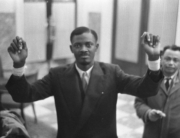
A car stranded in frozen Lake Baikal in Aquarela (Victor Kossakovsky and Ben Bernhard/Sony Pictures Classics)
“Aquarela” is the Portuguese word for “watercolor,” and Russian director Victor Kossakovsky’s ruminative documentary paints with water and color, vividly capturing the grayish white of Russia’s frozen Lake Baikal, the blueish-greenish tint of icebergs calving off the coast of Greenland, the oily black of massive Atlantic waves, and the rainbow sheen of Venezuela’s Angel Falls.
Beautifully filmed at a rare 96 frames-per-second with the latest high-tech stabilization equipment and waterproof cameras across seven countries—Scotland, Mexico, Russia, Greenland, Venezuela, Portugal, and the United States—this is a not a nature documentary in the traditional sense with talking heads and a sentimental score but a visual and aural celebration of the power of water; its style and scope is reminiscent of Godfrey Reggio’s 1982 cult classic Koyaanisqatsi: Life Out of Balance. (Kudos to Kossakovsky and his co-director of photography Ben Bernhard.)
Accompanying the stunningly crisp, clear images (a gliding schooner is dwarfed by a glacial landscape) are Russian sound designer Alexander Dudarev’s awe-inspiring recordings of water in all its forms (trickling, rushing, crackling, popping, exploding, crashing), but the mood is disrupted, at times, by the bombastic rock of Finnish composer Eicca Toppinen and his “cellometal” band Apocalyptica.
Water is the star here; humans, dwarfed by its might and energy, play minor, supporting roles. The co-skippers, Hayat Mokhenache and Peter Madej, of the schooner Polski Hak battle 30-foot waves and 40-knot winds as they sail across the stormy Atlantic. Inuits commute by motorboat among the immense ice floes near their Greenland village. Resourceful Siberian locals, using homemade wooden gear screwed into the ice, haul up SUVs submerged under the ice of Lake Baikal.
Climate change is never specifically alluded to, but viewers see the effects of unexpected temperature shifts in the film’s most startling and shocking scene when a car racing across frozen Lake Baikal suddenly plunges through the thinning ice. By the time Kossakovsky’s crew arrive at the accident site, one of the passengers has drowned as his companions are overwhelmed with grief. The spectacular shots of collapsing ice in Greenland and Hurricane Maria striking Miami also hint at the consequences of global warming.
This movie is not for everyone. Some may be bored by the lack of narrative, but film buffs who love striking and haunting imagery (oh, those swimming horses!) should see this on the biggest screen with the best sound system available for the full, immersive experience.






Leave A Comment